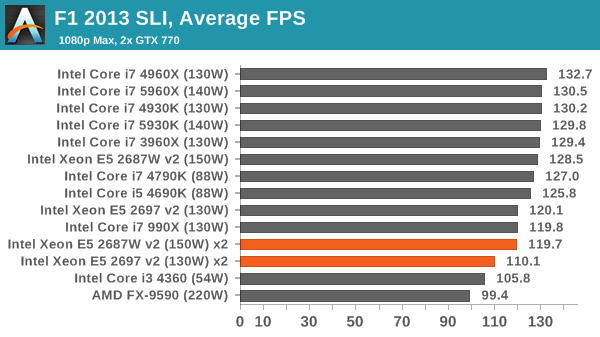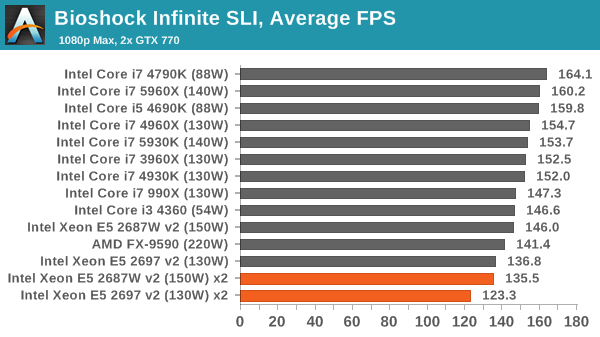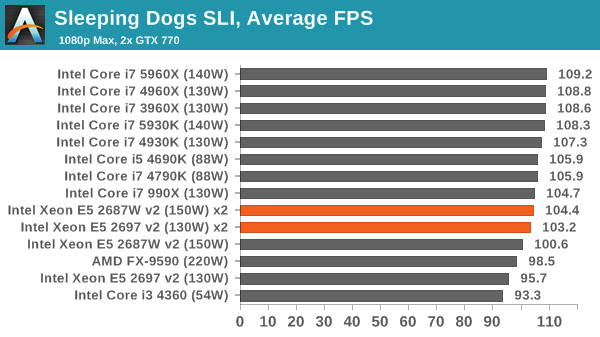GIGABYTE Server GA-7PESH3 Motherboard Review
by Ian Cutress on September 4, 2014 2:00 PM EST- Posted in
- Motherboards
- Intel
- Gigabyte
- Xeon
- Workstation
- Enterprise
- C602
Gaming Benchmarks
While gaming is not a focus of motherboards like the GIGABYTE GA-7PESH3, the system may be in use by content developers relying on an accurate representation with what they are making. GIGABYTE also includes a variety of multiple GPU connectors in the box, indicating that gaming is a use for this system. Gaming on 2P systems is usually restricted by the low single core speed of the processors used, or the memory mismanagement as games are not written to take advantage of a NUMA topology. In fact, our usual Tomb Raider benchmark failed to start at all, suggesting that a 2P system might be wholly engine dependent on what actually works or not. Games that are often heralded as using multiple cores are also usually stumped due to the dual processor nature of the system, causing cross CPU connections to add in extra latency and delays for data.
F1 2013
First up is F1 2013 by Codemasters. I am a big Formula 1 fan in my spare time, and nothing makes me happier than carving up the field in a Caterham, waving to the Red Bulls as I drive by (because I play on easy and take shortcuts). F1 2013 uses the EGO Engine, and like other Codemasters games ends up being very playable on old hardware quite easily. In order to beef up the benchmark a bit, we devised the following scenario for the benchmark mode: one lap of Spa-Francorchamps in the heavy wet, the benchmark follows Jenson Button in the McLaren who starts on the grid in 22nd place, with the field made up of 11 Williams cars, 5 Marussia and 5 Caterham in that order. This puts emphasis on the CPU to handle the AI in the wet, and allows for a good amount of overtaking during the automated benchmark. We test at 1920x1080 on Ultra graphical settings.

F1 2013 typically loves cores and frequency, however there is little gain here over an i3 except for 10-16 FPS in single GPU average frame rates.
Bioshock Infinite
Bioshock Infinite was Zero Punctuation’s Game of the Year for 2013, uses the Unreal Engine 3, and is designed to scale with both cores and graphical prowess. We test the benchmark using the Adrenaline benchmark tool and the Xtreme (1920x1080, Maximum) performance setting, noting down the average frame rates and the minimum frame rates.

Similarly Bioshock Infinite sees the 2P system at the bottom of the pack, especially in minimum frame rates.
Sleeping Dogs
Sleeping Dogs is a benchmarking wet dream – a highly complex benchmark that can bring the toughest setup and high resolutions down into single figures. Having an extreme SSAO setting can do that, but at the right settings Sleeping Dogs is highly playable and enjoyable. We run the basic benchmark program laid out in the Adrenaline benchmark tool, and the Xtreme (1920x1080, Maximum) performance setting, noting down the average frame rates and the minimum frame rates.

The only benchmark where the 2P shines is Sleeping Dogs in minimum frame rates under SLI. Here there is a distinct advantage of having dual processors over a single processor, moving well above 60 FPS minimum. However, the cost for those extra frames makes any other processor seem more palatable.
Battlefield 4
The EA/DICE series that has taken countless hours of my life away is back for another iteration, using the Frostbite 3 engine. AMD is also piling its resources into BF4 with the new Mantle API for developers, designed to cut the time required for the CPU to dispatch commands to the graphical sub-system. For our test we use the in-game benchmarking tools and record the frame time for the first ~70 seconds of the Tashgar single player mission, which is an on-rails generation of and rendering of objects and textures. We test at 1920x1080 at Ultra settings.

Finalising why gaming isn't great on a 2P machine: for Battlefield 4 the i3 scores similar or better than our 2P arrangement.
The end result of the story is: you can game on a dual processor workstation, but it won't be the best experience you can get.














35 Comments
View All Comments
tuxRoller - Saturday, September 6, 2014 - link
I found a reference on serverfault that says windows ultimate 7 supports up to two sockets. How well it is supported is another matter...than anandtech seems uninterested in investigating.Kevin G - Sunday, September 7, 2014 - link
The scheduler is the same between Windows 7 Pro and Windows 2008R2. The difference is in the configuration defaults.The more defining factor between a single and dual socket system in Windows is how it handles NUMA. Modern chips all have their own memory controller and things get complicated when a thread running on one processor requests data off the memory in another socket. That'll cause a slow down due to the additional latencies involved. Ideally the scheduler will run a thread on the same socket as the memory it accesses but for large data sets, this isn't possible or practical to continually context switch were a thread runs. This is why having a system with the same clock speed, the same number of cores and the same amount of memory will generally be faster on a single socket than a dual.
Filiprino - Sunday, September 7, 2014 - link
What about pinning a game to a socket?You should get the same performance as the equivalent single socket CPU, same frequency.
Gonemad - Monday, September 8, 2014 - link
I believe the point of the reviewer was to prove this motherboard is worthless to gaming enthusiasts, that will get better bang for buck elsewhere.It could be a tremendous gaming platform back in the single-core day, as it was the case. I knew a couple of people that built gaming machines out of server parts exactly to get the benefits of a dual-core system, even when the applications were not built for it, but just forcing Windows to run on the 2nd chip, while the game would run on the 1st. At least, that was the consensus back then, however wrong that may be.
Today, it is proved to be a moot point, since you get more performance out of a single 8-core chip, with shared cache and optmizations, than relying on true dual-chip design to get your cores.
Applications that already relied on multiple cores just took a leap ahead, having so many of them to populate, which was evident on the compression software's benchs.
I believe that this whole benchmark is far from useless; it proves that this use case is totally incorrect for the purpose of gaming. On the other hand, the server platform is an excellent number cruncher, with the reliability to match it, but it can take some gaming on the side dish without effort. It won't take 'best bang for buck' lists by storm, but it won't force the buyer to build a machine just for gaming.
Arms9ForSoul - Tuesday, May 10, 2016 - link
As ohm's law becomes stagnant, and manufacturing size become's limited, it'd be nice to be able to buy a mainstream/performance mobo with multiple CPU sockets. This would also be an easy way to sell APU's since it would be cheaper and have "better" performance.